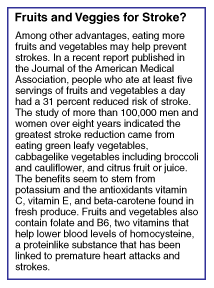New breakthroughs help in high-risk patients
By Elizabeth Smoots, M.D.
John was not the same after his stroke. His speech was garbled, one side of his face drooped, and his right grip was weaker than his left. But he was out of his leg splint and walking pretty well -- thanks to physical therapy -- when I saw him in the office. "I sure would have checked my blood pressure more often if I had known this would happen to me," he muttered. "I just didn't think it mattered, you know, now that I'm over the hill."
At age 72, John had more risk factors for stroke than simply high blood pressure. He was overweight and physically inactive, and he ate more fatty foods than he should have. These are just some of the many factors that can increase one's chance of suffering a stroke. The list also includes smoking, heavy drinking, high cholesterol levels, heart disease, hardening of the arteries, diabetes, and a personal or family history of stroke. Fortunately, there are several new ways to minimize -- or at least modify -- the risks using proven interventions.
Robert Hart, M.D., the lead researcher for several recent studies on stroke prevention, explains that "Control of risk factors is far below optimal, particularly hypertension, which is the most prevalent and important risk factor for stroke." As a result, stroke is the third-leading cause of death in this country, striking an estimated 731,000 and killing some 150,000 annually. A number of advances in recent years have improved our understanding of what causes strokes and how to prevent them.
Controlling blood pressure and heart beat
Prior to his stroke, John had been diagnosed with a form of high blood pressure called isolated systolic hypertension. Blood pressure is usually recorded as two numbers. A normal reading would be 120/80. The systolic, or upper, number is the pressure while your heart contracts, while the diastolic, or lower, number is the pressure taken during heart relaxation. In people with John's disorder, only the systolic pressure remains elevated. People are more susceptible to isolated systolic hypertension as they grow older, and in the past this form of high blood pressure was dismissed as a normal part of aging.
However, a study recently published in medical journal the Lancet found that drug therapy of isolated systolic hypertension reduced a patient's risk of stroke by 30 percent. The study followed more than 15,000 men and women aged 60 or older with high blood pressure for an average of four years. According to Dr. Hart, who is also a professor of neurology at the University of Texas, San Antonio, "Recognition of the importance of treating systolic hypertension is the most significant recent development in the primary prevention of stroke."
Dr. Hart also maintains that blood thinners are greatly underused in the treatment of a frequent cause of stroke due to a heart arrhythmia, called atrial fibrillation. Recent trials indicate that high-risk patients with chronic atrial fibrillation have about a two-thirds risk reduction in stroke when treated with the anticoagulant warfarin (Coumadin). Yet according to Dr. Hart, half of all patients in this country with atrial fibrillation who have other features indicating they are high-risk are not getting any kind of anticoagulation treatment.

Other advances that help prevent stroke
New research in heart patients shows that people who receive powerful cholesterol-lowering drugs called statins experience stroke 25 percent less than those who don't receive such drugs. Statins -- such as pravastatin (Pravachol), simvastatin (Zocor), and atorvastatin (Lipitor) -- are commonly used to treat elevated blood cholesterol levels. But Dr. Hart says that so far there is no evidence that these drugs help stroke victims or other patients with high cholesterol -- other than those who have had a heart attack or who have risk factors for heart disease.
Recently, the Food and Drug Administration approved several new anti-platelet agents for use in stroke prevention. These agents work by making the platelets in your blood less sticky and therefore less likely to clot. Occasionally, anti-platelet agents may trigger bleeding in the stomach or brain. Because of this, blood-thinning drugs are usually reserved for patients at high risk for stroke. Two of the medications, aspirin and ticlopidine (Ticlid), are already widely used to prevent recurrent stroke in patients who have had a previous one, including those who have had just a "warning stroke." Studies show a newly released drug called clopidogrel (Plavix) is equally effective for this purpose and may have fewer side effects.
For high-risk patients, research also holds promise for a recently approved combination of anti-platelet drugs consisting of aspirin and high-dose dipyridamole (Aggrenox), says Dr. Hart. "Some clinicians," he adds, "are awaiting the results of a trial (ongoing in Europe) to confirm the effects of this combination. At present aspirin remains the mainstay for anti-platelet therapy for stroke prevention, but the era of combination therapy is on the horizon."
Elizabeth Smoots, M.D., F.A.A.F.P., is a board-certified family physician in Seattle, Washington. A fellow of the American Academy of Family Physicians, Dr. Smoots writes about prevention and primary care medicine.
Related links:
Outside link: National Stroke Association
Send feedback on this article.

